by Enrique Moguel, Miguel Ángel Preciado and Juan Carlos Preciado
Smart Parking is based on a software system that links hardware and software, with support from Augmented Reality technologies, to provide an enhanced solution in the query of information regarding parking spaces. Smart Parking responds to the need of people with disabilities who have to know the availability of adapted parking spaces.
Under the promise of improving the management and efficiency of cities, the concept of Smart Cities has gained relevance over recent years. Local councils have promoted individual Smart City practices through investments in different sensor systems, infrastructures, measurements and modernisation. An enormous amount of data is now available, collected from sensors with different architectures and specifications. The challenge in turning this into relevant information for citizens. This project aimed to research and develop a single framework for the design of an integral Smart City strategy based on a single plug&play scalable system and diverse data sources.
The Quercus Software Engineering Group, University of Extremadura in collaboration with the Vodafone Spain Foundation designed (2013) and launched (2014) the first version of a Smart City living lab at the Polytechnic School of Cáceres, thus transitioning it into a Smart Campus. A campus environment features the majority of behaviours that occur across the broader city environment.
One of the main problems that citizens and municipalities face is the mobility and parking. This is the main motivation for the Smart Parking project. The goal of this project was to design a low-cost single system that allowed for different data sources to connect in a plug&play mode, being scalable and mainly based on software engineering techniques. This system would 1) offer drivers real-time assistance to find available parking spaces near them, 2) know the occupation ratios for taking decisions about parking space vehicle occupancy and 3) provide useful information for disabled people who typically require more time to find free parking spaces.
In this context, sensors were installed in the parking spaces of the Cáceres campus, using three different data source technologies. We aim to compare reliability, costs, performance, and other factors between the different technologies [1] in an empirical way to determine which is best.
Hardware architecture
The architecture of the system is based on a three-layer model, Producers-Server-Consumers, in which sensor devices are responsible for producing (PRODUCERS) and sending data to the server [2]; the server (SERVER) gives intelligence to the system using algorithms that transforms the data into relevant information; and the users (CONSUMERS) that query this information in real-time.
The layer of the data producers (PRODUCERS) is formed by three types of sensors which are outlined in Table 1.
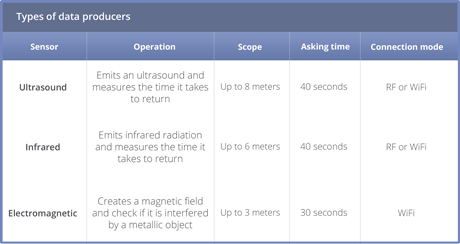
The data produced by the sensors are sent to the server, where the occupancy status of each parking spaces is stored. This layer is responsible for providing intelligence to the system, processing all data captured and transforming them into relevant information. Then the users can access the services offered by the system from any device with internet access. They can check the real-time occupancy status of parking spaces and view the history of occupation. It is also possible to know if a space is under- or over-utlized. The Smart Parking architecture is shown in Figure 1.
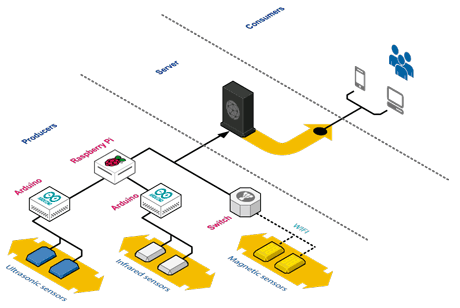
Software architecture
The software layer has been developed using web engineering technologies (WebRatio 7.1/HTML 5) and provide access to any user from any device with internet access. The main view of the system is shown in Figure 2.
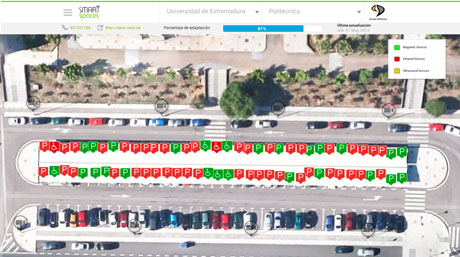 Augmented reality layer
Augmented reality layer
In innovative addition has been development of an augmented reality system [3] that provides the user with context to around where the parking spaces are placed. This differential technology solution can help any user find the correct position of a parking space and its occupancy status.
Conclusions and future lines
Developing a single plug&play scalable multi-layer system has enabled us to conceptualize the design of a Smart City (parking dimension). This development process was founded on our extensive R&D of systems engineering but innovation opportunities that came from lessons learnt also played a key role. These lessons were from experiences in a wide range of fields including big data, cloud computing, business intelligence, business analytics, data visualization, open data and packed services.
This experience has allowed us to manage Smart City concepts at the laboratory level and investigate different software/hardware alternatives. A system based on software engineering offers a scalable and plug&play design and at the sensing level we can develop a low-cost product.
We are also managing cameras (available in Figure 3) which sense parking places via software. In investigating this avenue, we are seeking to maximise the opportunities (i.e., cheaper infrastructure, more control about cars) but solve the associated problems (i.e., more server processing).
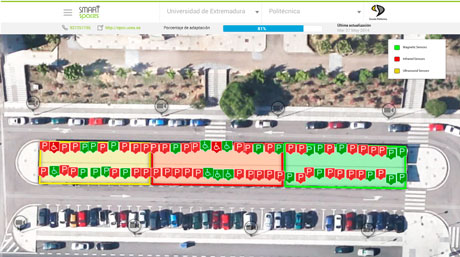
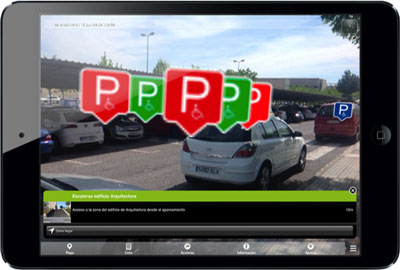
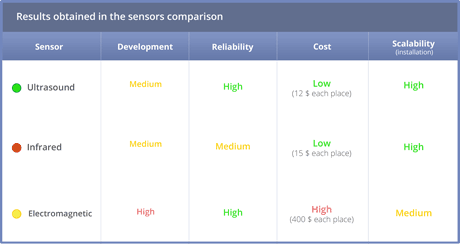
Acknowledgement:
Work funded by Spanish Contract MIGRARIA - TIN2011-27340 at Ministerio de Ciencia e Innovacion and Gobierno de Extremadura (GR-10129) and European Regional Development Fund (ERDF)
Link: http://uex.be/SmartSpaces
References:
[1] G. Revathi, V.R.S.Dhulipala: “Smart parking systems and sensors: A survey”, in proc. of Computing, Communication and Applications (ICCCA), Prag 2012, p.1-5
[2] U. Männi: “Smart sensing and time of arrival based location detection in Parking Management services”, in proc. of Electronics Conference (BEC) 2010, p. 213-214.
[3] P. Pulli: “Mobile Multimodal Virtual Reality for Personal Teleservices”, ERCIM News No.31, October 1997.
Please contact:
Enrique Moguel, University of Extremadura,, Spain.
E-mail:
Miguel Ángel, Preciado, Homeria Open Solutions, Spain.
E-mail:
Juan Carlos, PreciadoUniversity of Extremadura, Spain.
E-mail:











